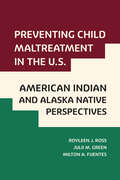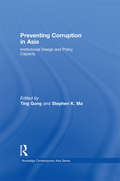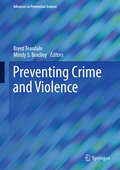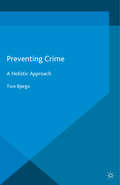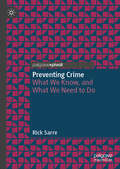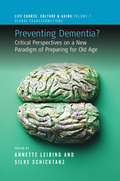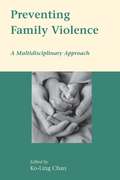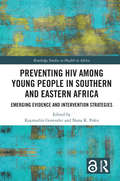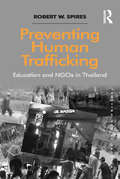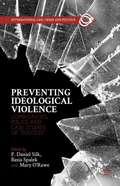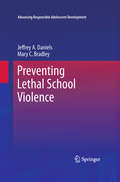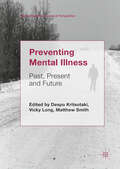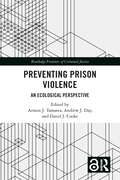- Table View
- List View
Preventing Child Maltreatment in the U.S.: American Indian and Alaska Native Perspectives (Violence Against Women and Children)
by Milton A Fuentes Royleen J Ross Julii M GreenThis book is part of a concentrated series of books that examines child maltreatment across minoritized, cultural groups.Specifically, this volume addresses American Indian and Alaska Native populations. However, in an effort to contextualize the experiences of 574 federally recognized tribes and 50+ state recognized tribes, as well as villages, the authors focus on populations within rural and remote regions and discuss the experiences of some tribal communities throughout US history. It should be noted that established research has primarily drawn attention to the pervasive problems impacting Indigenous individuals, families, and communities. Aligned with an attempt to adhere to a decolonizing praxis, the authors share information in a strength-based framework for the Indigenous communities discussed within the text. The authors review federally funded programs (prevention, intervention, and treatment) that have been adapted for tribal communities (e.g., Safecare) and include cultural teachings that address child maltreatment. The intention of this book is to inform researchers, practitioners, policy makers, and advocates about the current state of child maltreatment from an Indigenous perspective.
Preventing Child Maltreatment in the U.S.: Multicultural Considerations (Violence Against Women and Children)
by Milton A Fuentes Rachel R. Singer Renee L. DeBoard-LucasPreventing Child Maltreatment: Multicultural Considerations in the United States is the first book in a concentrated series that examines child maltreatment across minoritized, cultural groups. Specifically, this volume examines core multicultural concepts (e.g., intersectionality, acculturation, spirituality, oppression) as they relate to child maltreatment in the United States, while the other books take a closer look at particular ethnic or racial communities in this country. Additionally, this book examines child maltreatment through the intersection of feminist, multicultural, and prevention/wellness promotion lenses. Recommendations for treatment in each book build on a foundation of prevention and wellness promotion, along with multicultural and feminist theories. Throughout this book, five case studies, which are introduced in Chapter One, are revisited to help the readers make important and meaningful connections between theory and practice.
Preventing Child Maltreatment in the U.S.: The Black Community Perspective (Violence Against Women and Children)
by Melissa Phillips Shavonne Moore-Lobban Milton A FuentesChild maltreatment occurs in the Black community at higher rates than any other racial group. Given the prevalence of child maltreatment risk factors in the Black community, such as being in a low-income family, single parent family, greater exposure to physical discipline, and less access to services and resources, it is not surprising but nonetheless concerning that Black children are at greater risk for abuse and/or neglect. Unearthing the cause and effect between the challenges faced by the Black community and the life outcomes for Black children is key to making positive changes happen. Through a feminist and womanist lens, the authors unpack the range of factors that intersect and impact the Black community that are necessary to address to effectively protect Black children. Understanding how to prevent maltreatment and promote health and wellness are essential to adequately address maltreatment so as to protect and empower Black children.
Preventing Child Maltreatment in the U.S.: The Latinx Community Perspective (Violence Against Women and Children)
by Milton A Fuentes Esther J. Calzada Monica Faulkner Catherine LaBrenzThis book is part of a concentrated series of books that examines child maltreatment across cultural groups. Specifically, this volume examines core concepts relevant to Latinx families (e.g., familismo, acculturation, spirituality, oppression) as they relate to child maltreatment in the United States. While there are vast differences across Latinx families, authors use critical race and feminist theories to explore the impact of differences based on gender, race, immigration status, and country of origin. The book begins by contextualizing child maltreatment in Latinx families within the pervasive structural racism and inequality in the United States and addressing unique traumas experienced by Latinx families resulting from that inequity. Subsequent chapters address prevention of child maltreatment, responses to maltreatment and healing from trauma with an emphasis on resilience within the Latinx community. Three case studies are used to illustrate and apply concepts from each chapter.
Preventing Child Sexual Abuse: Evidence, Policy and Practice (Crime Science Series)
by Richard Wortley Stephen Smallbone William L. MarshallPublic policy responses to child sexual abuse are dominated by interventions designed to take effect only after offenders have already begun offending, and after children have already been sexually abused. Comparatively little attention has been given to alternative prevention strategies – particularly to those aimed at preventing sexual abuse before it might otherwise occur. Considerable knowledge has been accumulated on the characteristics, modus operandi and persistence of offenders, the characteristics, circumstances and outcomes for victims, and the physical and social settings in which sexual abuse occurs, but little work has been done to systematically apply this knowledge to prevention.This book aims to fulfill this objective through integrating clinical and criminological concepts and knowledge to inform a more comprehensive and effective public policy approach to preventing child sexual abuse. Empirical and theoretical knowledge concerning child sexual abuse is integrated with broader developments in evidence-based crime and child maltreatment prevention, leading to new ideas about understanding and preventing child sexual abuse. This book will be essential reading for anybody with interests in this field.
Preventing Coronary Heart Disease: Prospects, Policies, and Politics
by Michael CalnanFirst published in 1991. Routledge is an imprint of Taylor & Francis, an informa company.
Preventing Corruption in Asia: Institutional Design and Policy Capacity (Routledge Contemporary Asia Series #Vol. 15)
by Ting Gong Stephen K. MaDespite intensified governmental and public efforts at corruption control in recent years, official transgression continues to surface in various ways of abusing the unique power and trust that a government holds. Preventing Corruption in Asia addresses a number of crucial questions: -What institutional arrangements are necessary to ensure a clean and honest government? - What self-regulatory capabilities must government institutions develop in order to maintain integrity? -How should a sense of ethical responsibility be instilled in the civil services? -Do special anti-corruption agencies help keep government clean? -How will a regulatory framework of official conduct work properly? -How useful are anti-corruption campaigns in containing corruption? Focusing on a number of carefully selected countries in the Asia and Pacific region, the book sets as its focal point the choice of institutional design in preventing corruption, rather than treating corruption as a practical or technical problem to be corrected by strong political will and good anti-corruption policy measures. While focusing on institutional designs and policy choices, the book also examines other aspects of clean government such as the social environment, legal and regulatory framework, role of the public, and the impact of culture.
Preventing Crime and Disorder in Public Places: Blending Opportunity Reduction, Guardianship and Welfare (Crime Prevention and Security Management)
by Tim PrenzlerThis accessible, short book provides scientifically informed guidance on effective wholistic place management strategies for preventing crime. It integrates theoretical perspectives and practical examples of crime prevention methods that can be readily implemented by responsible stakeholders. It covers locations including town centers, shopping malls, parks, beaches, transit hubs, campuses, stadiums and entertainment precincts, where security programs sometimes attract criticism regarding the exclusion or persecution of marginalized groups. This book advocates for overlapping forms of crime prevention and social support that address the need to make large improvements in safety in public places while supporting marginalized and vulnerable groups. Readers are exposed to a wide range of successful case studies as well as the central role of a systematic problem-solving methodology. It speaks to crime prevention and social services professionals, academics, and students, as well as interested members of the public.
Preventing Crime and Violence
by Brent Teasdale Mindy S. BradleyThis insightful volume integrates criminological theories, prevention science, and empirical findings to create an up-to-date survey of crime prevention research and strategies. Its interdisciplinary perspective expands on our knowledge of risk factors to isolate the malleable mechanisms that produce criminal outcomes, and can therefore be targeted for intervention. In addition, the text identifies developmental, lifespan, and social areas for effective intervention. Reviews of family-, community-, and criminal justice-based crime prevention approaches not only detail a wide gamut of successful techniques, but also provide evidence for why they succeed. And as an extra research dimension, the book's chapters on methodological issues and challenges uncover rich possibilities for the next generation of crime prevention studies. Included in the coverage: Integrating criminology and prevention research Social disorganization theory: its history and relevance to crime prevention Research designs in crime and violence prevention Macro- and micro-approaches to crime prevention and intervention programs Implications of life course: approaches for prevention science Promising avenues for prevention, including confronting sexual victimization on college campuses Spotlighting current progress and continuing evolution of the field, Preventing Crime and Violence will enhance the work of researchers, practitioners, academicians, and policymakers in public health, prevention science, criminology, and criminal justice, as well as students interested in criminology and criminal justice.
Preventing Crime: A Holistic Approach (Crime Prevention and Security Management)
by Tore BjørgoTraditional "schools" of crime prevention, like the criminal justice model, social crime prevention or situational crime prevention, have proved to be too narrow and do not combine well with other approaches. However, each of these models provides important insights and contributions for reducing crime. By extracting the main preventive mechanisms of these diverse approaches, this book develops a more holistic, general model that consists of nine preventive mechanisms: building normative barriers to crime, reducing recruitment, deterrence, disruption, incapacitation, protecting vulnerable targets, reducing benefits of crime, reducing harm, and facilitating desistance. The measures to activate the preventive mechanisms may differ according to the type of crime, as may the actors in charge of implementing the relevant measures. However, Tore Bjørgo demonstrates how his model of crime prevention can be effectively applied to diverse forms of crime, from domestic burglaries to criminal youth gangs and driving under the influence to organized crime and terrorism. In doing so, this important book will be of interest to scholars and students of policing, security studies and criminology, as well as practitioners and policy-makers.
Preventing Crime: What We Know, and What We Need to Do
by Rick SarreThis book summarises the latest findings of Australian and international crime prevention researchers and suggests how future policies based upon their evidence could and should be better shaped and employed by policymakers. Governments all over the world are constantly endeavouring to make their communities safer and the lives of their citizens less fearful. For decades now, criminological researchers, challenged to assist in this task, have been asking: “What is working to reduce crime?” “What could work better in preventing crime before it erupts?” “What have we not tried, but could try in the field of crime control?” Pleasingly, the research outputs on this subject are voluminous and growing. They regularly inform policymaking in productive ways. This, in turn, has led and continues to lead to good crime prevention outcomes, but a lot more could be done. The author sets out twelve key priorities, designed to reduce victimisation, and tackle street crime and white-collar crime especially, each of them based upon a social justice framework. These priorities draw upon his extensive writings on the topic of law and criminology over the past forty years. There is, he concludes, far more value in tackling the societal factors that allow crime to emerge, grow and persist than applying a strict application of the criminal law and the justice system that feeds upon it.
Preventing Dementia?: Critical Perspectives on a New Paradigm of Preparing for Old Age (Life Course, Culture and Aging: Global Transformations #7)
by Annette Leibing and Silke SchicktanzThe conceptualization of dementia has changed dramatically in recent years with the claim that, through early detection and by controlling several risk factors, a prevention of dementia is possible. Although encouraging and providing hope against this feared condition, this claim is open to scrutiny. This volume looks at how this new conceptualization ignores many of the factors which influence a dementia sufferers’ prognosis, including their history with education, food and exercise as well as their living in different epistemic cultures. The central aim is to question the concept of prevention and analyze its impact on aging people and aging societies.
Preventing Family Violence
by Ko-Ling ChanFamily violence, including intimate partner violence, elder abuse and child maltreatment, is a serious and deteriorating social problem. It may cause irreparable damage to the victim's physical and mental health, as well as social functioning, welfare, and legal status. Previous efforts to formulate preventive measures under different disciplines are often ineffective. This book is among the first attempts to integrate perspectives from different inter-related disciplines into the development of preventive strategies for family violence. Experts from health, legal, social work, sociology, and psychology have contributed to the multidisciplinary approach based on their professional discretion.
Preventing Famine: Policies and prospects for Africa
by Donald Curtis Andrew Shepherd Michael HubbardSome urgent new thinking is needed if any lessons are to be learnt from the recent disasters. This book brings together the experience of a number of writers who have worked on, or studied, poverty alleviation programmes in Asia and Africa.
Preventing HIV Among Young People in Southern and Eastern Africa: Emerging Evidence and Intervention Strategies (Routledge Studies in Health in Africa)
by Nana K. Poku Kaymarlin GovenderThis book provides an overview of the current epidemiology of the HIV epidemic among young people in Eastern and Southern Africa (ESA) and examines the efforts to confront and reduce the high level of new HIV infections amongst young people. Taking a multi-dimensional approach to prevention, the contributors discuss the many challenges facing these efforts, in view of the slow progress in curbing the incidence of HIV amongst young people, focusing particularly on the structural and social drivers of HIV. Through an examination of these issues, chapters in this book provide valuable insights on how to mitigate HIV risk among young people and what can be regarded as the catalysts to mounting credible policy and programmatic responses required to achieve epidemic control in the region. The contributors draw on examples from a range of primary and secondary data sources to illustrate promising practices and challenges in HIV prevention, demonstrating links between conceptual approaches to prevention and lessons learnt from implementation projects in the region. Bringing together social scientists and public health experts who are actively engaged in finding effective solutions, the book discusses ‘which interventions works’, ‘why they work’, and the limitations and gaps in our knowledge to curb the pandemic amongst young people. As such it is an important read for researchers focusing on HIV/AIDS and public health.
Preventing Human Trafficking: Education and NGOs in Thailand (Solving Social Problems)
by Robert W. SpiresThis book explores human trafficking, examining the work of grass-roots, non-profit organizations who educate and rehabilitate human trafficking victims and at-risk youth. Through interviews with staff and children, the author compares the work of two NGOs on-the-ground in Thailand with the work of similar organizations overseas, shedding light on the ways in which they combine educational work with shelter settings to prevent human trafficking, protect young people and attempt to provide a future free of exploitation. Concentrating less on the details of exploitation itself than the work that is being done to prevent exploitation and protect those who have experienced human trafficking, Preventing Human Trafficking explores the many challenges faced by the organizations, their staff and the children they serve. Drawing on rich qualitative research to address significant gaps in our knowledge of the work of NGOs and propose solutions to the problems of trafficking and how to protect its victims, this book will appeal to social scientists and policy makers with interests in criminology, exploitation, people trafficking, non-formal education and the work of NGOs.
Preventing Ideological Violence
by Basia Spalek P. Daniel Silk Mary O’raweThis book presents the voices of police and community members who have been involved in engagement and partnership projects designed for countering violent extremism. Though the threat of the so-called Islamic State garners a great deal of current attention, the book explores ideological violence prevention efforts in a number of contexts, to include that of paramilitary organizations as well as Qa'ida inspired actors.
Preventing Lethal School Violence
by Jeffrey A. Daniels Mary C. BradleyBullying. Gang assaults. Rampage shootings. School violence, especially when it turns deadly, has enduring social and psychological effects on students, faculty, staff, and the community. And though a great deal of research focuses on the significant role children's positive social development plays in reducing incidents of school violence, in-depth examinations of evidence-based preventive measures have remained minimal until now. With its focus on averting lethal school violence, this unique volume translates the prosocial findings into practicable preventive measures that can be put to use in school settings. Making expert use of news reports as well as scholarly data, Preventing Lethal School Violence clarifies the links between bullying and lethal violence and delineates typical characteristics of school shooters while cautioning against outright profiling. Students' awareness of self and others, strong connections with adults, and other social and ethical skills form the basis of a comprehensive, research-based model for reducingâ "and potentially eliminatingâ "lethal incidents at school. This accessible volume: Outlines the scope of school violence as a broader social problem. Summarizes current information on the traits common to students who commit lethal violence at school. Examines the relationship between bullying/cyberbullying and rampage incidents. Analyzes examples of successful prevention of violent acts and resolution of hostage situations. Describes in detail the concept of positive school climate and introduces the Safe School Communities Model. Synthesizes key research data into violence prevention skills for students, teachers, administrators, and all professionals working in schools. Preventing Lethal School Violence is a must-have resource for researchers and professionals in school psychology and allied education disciplines, including school administration, school counseling, and social work.
Preventing Mental Illness: Past, Present and Future (Mental Health in Historical Perspective)
by Matthew Smith Vicky Long Despo KritsotakiThis book provides an overview of a diverse array of preventive strategies relating to mental illness, and identifies their achievements and shortcomings. The chapters in this collection illustrate how researchers, clinicians and policy makers drew inspiration from divergent fields of knowledge and practice: from eugenics, genetics and medication to mental hygiene, child guidance, social welfare, public health and education; from risk management to radical and social psychiatry, architectural design and environmental psychology. It highlights the shifting patterns of biological, social and psychodynamic models, while adopting a gender perspective and considering professional developments as well as changing social and legal contexts, including deinstitutionalisation and social movements. Through vigorous research, the contributors demonstrate that preventive approaches to mental health have a long history, and point to the conclusion that it might well be possible to learn from such historical attempts. The book also explores which of these approaches are worth considering in future and which are best confined to the past. Within this context, the book aims at stoking and informing debate and conversation about how to prevent mental illness and improve mental health in the years to come.Chapters 3, 10, and 12 of this book are available open access under a CC BY 4.0 license at link.springer.com
Preventing Palestine: A Political History from Camp David to Oslo
by Seth AnziskaOn the fortieth anniversary of the Camp David Accords, a groundbreaking new history that shows how Egyptian-Israeli peace ensured lasting Palestinian statelessnessFor seventy years Israel has existed as a state, and for forty years it has honored a peace treaty with Egypt that is widely viewed as a triumph of U.S. diplomacy in the Middle East. Yet the Palestinians—the would-be beneficiaries of a vision for a comprehensive regional settlement that led to the Camp David Accords in 1978—remain stateless to this day. How and why Palestinian statelessness persists are the central questions of Seth Anziska’s groundbreaking book, which explores the complex legacy of the agreement brokered by President Jimmy Carter.Based on newly declassified international sources, Preventing Palestine charts the emergence of the Middle East peace process, including the establishment of a separate track to deal with the issue of Palestine. At the very start of this process, Anziska argues, Egyptian-Israeli peace came at the expense of the sovereignty of the Palestinians, whose aspirations for a homeland alongside Israel faced crippling challenges. With the introduction of the idea of restrictive autonomy, Israeli settlement expansion, and Israel’s 1982 invasion of Lebanon, the chances for Palestinian statehood narrowed even further. The first Intifada in 1987 and the end of the Cold War brought new opportunities for a Palestinian state, but many players, refusing to see Palestinians as a nation or a people, continued to steer international diplomacy away from their cause.Combining astute political analysis, extensive original research, and interviews with diplomats, military veterans, and communal leaders, Preventing Palestine offers a bold new interpretation of a highly charged struggle for self-determination.
Preventing Prison Violence: An Ecological Perspective (Routledge Frontiers of Criminal Justice)
by Armon J. Tamatea Andrew J. Day David J. CookePreventing Prison Violence introduces the idea of ‘prison ecologies’ – a multi-layered perspective to understanding prison violence as a ‘product’ of human, environment (social and physical), systemic, and societal influences – and how an ecological approach is helpful to prevention efforts.Interpersonal violence is a global concern and a significant cause of death around the world. In prisons, the human, financial, and health burden of violence presents a significant social issue – as well as a ‘wicked problem’ that does not permit of simplistic solutions. Recent innovations in data capture means that questions about violence, gang-affiliations, and prisons that could not be answered previously can now be explored. The central theme of this book is that prisons are ‘ecologies’ – spaces where people, resources, and the built environment are interrelated – and that violence is a product of a complex of interpersonal and environmental factors that increase the likelihood of assault – but also provide opportunities for solutions. Drawing on psychology, geography, indigenous knowledge, gang culture, and predictive modelling, this book expands beyond the conventional individual-focused ‘assessment-intervention-prevention’ approach to research in this field, towards a holistic and ecological way of thinking that recognises individual, organisational, and cultural factors, as well as the role of the physical environment itself in the facilitation and prohibition of aggression.Providing a comprehensive resource for those who are interested in making prisons safer; firmly based in contemporary research and theory, Preventing Prison Violence will be of great interest to students and scholars of Penology, Violence and Forensic Psychology, as well as to professionals working in criminal justice settings.The Open Access version of this book, available at http://www.taylorfrancis.com, has been made available under a Creative Commons [Attribution-Non Commercial-No Derivatives (CC BY-NC-ND)] 4.0 license.
Preventing Prison Violence: An Ecological Perspective (Routledge Frontiers of Criminal Justice)
by Armon J. Tamatea, Andrew J. Day, and David J. CookePreventing Prison Violence introduces the idea of ‘prison ecologies’ – a multi-layered perspective to understanding prison violence as a ‘product’ of human, environment (social and physical), systemic, and societal influences – and how an ecological approach is helpful to prevention efforts. Interpersonal violence is a global concern and a significant cause of death around the world. In prisons, the human, financial, and health burden of violence presents a significant social issue – as well as a ‘wicked problem’ that does not permit of simplistic solutions. Recent innovations in data capture means that questions about violence, gang-affiliations, and prisons that could not be answered previously can now be explored. The central theme of this book is that prisons are ‘ecologies’ – spaces where people, resources, and the built environment are interrelated – and that violence is a product of a complex of interpersonal and environmental factors that increase the likelihood of assault – but also provide opportunities for solutions. Drawing on psychology, geography, indigenous knowledge, gang culture, and predictive modelling, this book expands beyond the conventional individual-focused ‘assessment-intervention-prevention’ approach to research in this field, towards a holistic and ecological way of thinking that recognises individual, organisational, and cultural factors, as well as the role of the physical environment itself in the facilitation and prohibition of aggression. Providing a comprehensive resource for those who are interested in making prisons safer; firmly based in contemporary research and theory, Preventing Prison Violence will be of great interest to students and scholars of Penology, Violence and Forensic Psychology, as well as to professionals working in criminal justice settings.
Preventing Radicalization: Education for Responsibility, a Means of Primary Prevention of Violent Radicalization (ISTE Invoiced)
by Mohammed El OurmiFaced with the growing and persistent threat of radicalization, both in France and worldwide, it is crucial to explore new approaches to prevention. Preventing Radicalization proposes an innovative method for understanding and preventing violent radicalization, focusing on the development of individual responsibility through the enhancement of psychosocial skills. It examines the limits of traditional approaches centered on security and justice, and proposes concrete, innovative strategies focused on the search for solutions, notably through educational and awareness-raising programs. This integrated, humanistic approach, which aims to strengthen epistemic, emotional, attentional, relational and axiological skills, represents a significant advance in the primary prevention of violent radicalization processes. In a context where radicalization continues to threaten the stability of societies, it is imperative to rethink prevention strategies. This book provides the essential keys to understanding this complex threat for all those who wish to tackle it.
Preventing Sexual Harm: Positive Criminology and Sexual Abuse (Routledge Studies in Crime and Society)
by Mohammed Rahman Stephanie Kewley Sarah PembertonPreventing Sexual Harm provides an overview of current criminal justice strategies to tackling sexual violence, and highlights existing positive criminological approaches that could help prevent sexual abuse and harm. Sexual violence is a complex, multi-faceted crime. Its causes and consequences are both multiple and enduring and our understanding of sexual violence is embedded within our social, cultural and political constructs. As such, a response to sexual violence ought to be equally as complex and multi-faceted. Alternative approaches might therefore be needed, such as Positive Criminology. In response, this book explores Positive Criminology as a mechanism to reduce the risk of recidivism, eradicate harm, prevent re-offending as well as helping to reintegrate those with histories of sexual abuse back into the community. In light of recent historical cases of sexual abuse and poor institutional response to these allegations, it opens with an overview of the current landscape of sexual offending. The book then reviews the current positive criminological approaches already in existence in the effort to prevent sexual abuse, outlining the approach of Positive Criminology and demonstrating the many gaps in practice that might benefit from this new way of working to prevent sexual abuse. Highlighting that an alternative response to sexual violence is needed, and presenting the idea that a positive criminological paradigm is worthy of further examination, this book will be of great interest to scholars of criminology, criminal justice and forensic psychology.
Preventing Sexual Violence
by Nicola Henry Anastasia PowellWhile there is much agreement about the scope of sexual violence, how to go about preventing it before it occurs is the subject of much debate. This unique interdisciplinary collection investigates the philosophy and practice of primary prevention of sexual violence within education institutions and the broader community.
